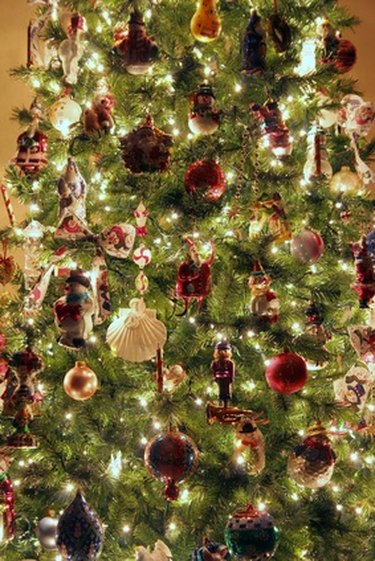
Christmas bubble lights add even more visual interest to a tree than standard strings of light, but under certain circumstances, they can be hazardous. If they break, the liquid inside could cause poisoning if ingested or inhaled, or if it's absorbed through skin. Vintage bubble string lights may pose an electrical hazard or a fire hazard if the light strands are not in good shape, but this is true of any strand lighting and of any electrical cord. Aside from the liquid in a bubble light, this type of holiday lighting is just about as safe as other incandescent Christmas light strands.
Chemicals in Christmas Bubble Lights
Video of the Day
The chemicals used in clear bubble lights are what makes them special... and potentially toxic. A bubble light is simply a light bulb with a liquid-filled tube above it. After a while, the heat from the light bulb warms the liquid enough that it boils, causing the desired bubbling effect. The light also illuminates the bubbling liquid, which makes the bubbling visible from across the room.
Video of the Day
Not just any liquid will do for a bubble light. Since these use small light bulbs as the heat source, the liquid in the glass vial has to have a low boiling point. Early on during the bubble-light craze, some light manufacturers tried making theirs with other liquids in the glass vials, but ultimately methylene chloride is the substance that bubbles the best at low temperature for this application. Even today, most bubble light vials are filled with methylene chloride.
According to National Capital Poison Center, methylene chloride converts to carbon monoxide in the human body. If a bubble light's glass vial breaks, such as when you're removing the strand from a box in storage, the liquid may get into your body through your skin or through inhalation. Ingesting it isn't an issue for an adult, but it could be for a young child. Once methylene chloride gets in the body, it could cause symptoms of carbon monoxide poisoning such as headaches, seizures, vomiting or even a heart attack. The amount of liquid in one bubble light isn't enough to cause serious health issues, notes the poison center.
Christmas Bubble Light Safety
Using bubble lights requires the same safety precautions as using other Christmas strand lights. When unpacking the bubble lights for the season, always inspect the electrical cord, the plug, the light socket bases and the lights themselves, looking for any signs of damage. Flex the cord in several places along the strand if the lights are relatively old. If the cord feels brittle and cracks, this could mean the coating on the wires is compromised, which could pose an electrical hazard. Discard the strand, but feel free to save the bulbs to test in another light strand.
If you see any exposed wire or indications that the plug is falling apart, don't use that light strand, as This Old House notes that it could be an electrical hazard. Once you ensure that the strand appears intact, check that every socket has a bulb in it. It's OK to put regular incandescent Christmas bulbs in the bubble light strand if they have the same base size. Plug the bubble light strand in it to test it; the lights beneath the glass vial in each bubble light should illuminate, indicating the light set is in good working order. Unplug it.
Use bubble lights only indoors unless their packaging clearly indicates they're for indoor and outdoor use. Don't leave bubble lights or any Christmas lights plugged in overnight if they're on a cut tree indoors. Christmas tree needles become dry and brittle after the tree is cut down, making them more prone to fire hazards. The heat from incandescent Christmas lights, including bubble lights, could cause the tree to catch fire after hours of exposure to the heat, especially if numerous strands are plugged into one another. LED lights are a better alternative, as they don't get as hot or use as much power – but there are no bubbling LED lights.